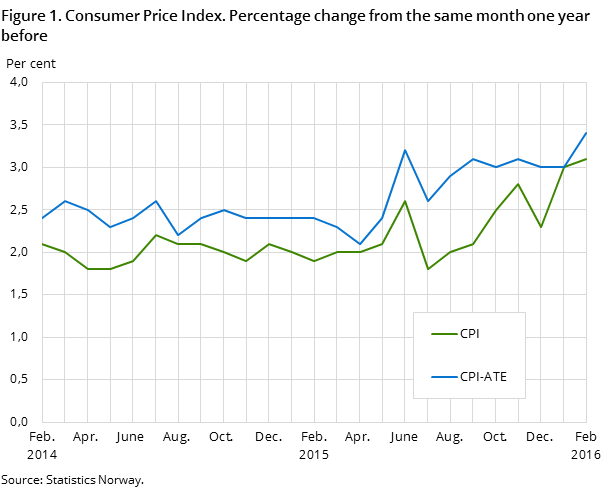Content
Published:
This is an archived release.
Increased food prices
The Consumer Price Index (CPI) rose 0.5 per cent from January to February 2016, mostly due to higher food prices. The year-to-year growth in the CPI was 3.1 per cent in February, up 0.1 percentage points from January.
| Monthly change (per cent) January - February | 12-month rate (per cent) February 2015 - February 2016 | Index February 2016 | |
|---|---|---|---|
| CPI All-item index | 0.5 | 3.1 | 142.7 |
| Food and non-alcoholic beverages | 3.4 | 3.3 | 135.8 |
| Housing, water, electricity, gas and other fuels | -1.3 | 1.8 | 174.6 |
| Transport | 0.7 | 2.2 | 152.1 |
| Recreation and culture | -0.2 | 4.6 | 126.5 |
| Clothing and footwear | 0.2 | 5.7 | 54.0 |
| CPI-ATE (July 1999 = 100) | 1.0 | 3.4 | 133.7 |
| CPI by delivery sector (December 2014 = 100) | |||
| Consumer goods | 0.6 | 3.5 | 103.7 |
| Services | 0.5 | 2.9 | 103.4 |
| Services where labor dominates | 0.2 | 2.5 | 103.9 |

The year-to-year CPI-ATE growth was 3.4 per cent in February. The CPI was 142.7 (1998=100) in February 2016, compared to 138.4 in February 2015, which corresponds to a year-to-year growth of 3.1 per cent.
Monthly change: rise in food prices
The CPI increased 0.5 per cent from January to February this year. The main factor was a 3.6 per cent increase in food prices. The increase in food prices must be viewed in conjunction with a price adjustment that normally appears in February and sales activities in the previous months. All food groups showed a price increase in February.
Airfares rose 17.7 per cent from January to February. The group with furniture had a price increase of 5.5 per cent. The increase comes after sales activity in January.
The increase in the CPI was mainly dampened by a price decrease of 8.9 per cent on electricity including grid rent. Prices of fuels and lubricants fell from January to February by 5.5 per cent.
Year-to-year growth: higher prices imported goods
The CPI rose 3.1 per cent from February 2015 to February 2016. Higher furniture prices were the largest contributor to the year-to-year growth. The group with furniture increased 7.5 per cent. Prices on clothes increased 6.6 per cent in the last twelve months. The price increase on furniture and clothes contributed to a 4.4 per cent price increase on imported goods excluding agricultural products.
The year-to-year growth in the CPI was mainly dampened by lower energy prices.
Change in the year-to-year growth: food prices pulled the growth rate up
The year-to-year growth in the CPI increased from 3.0 per cent in January to 3.1 per cent in February. The increased growth rate was mainly due to the development in prices of food and airfares. Food prices increased 3.6 per cent from January to February this year, compared to 1.8 per cent in the same period last year.
The price development in energy products pulled the growth rate in the opposite direction, as prices fell more from January 2016 to February 2016 than from January 2015 to February 2015. The year-to-year growth in the CPI-ATE was 3.4 per cent in February, up 0.4 percentage points from January.
New detailed consumer classification, ECOICOP.Open and readClose
The CPI adopted Eurostat’s new detailed 5-digit consumer classification, ECOICOP in January 2016. Statistics Norway has published unofficial 5 and 6-digit COICOP indices for the consumer group Food and non-alcoholic beverages up until January 2016. As a result of a discrepancy between the unofficial and the new official ECOICOP, some previously published indices are no longer available. This results in new names for some of the published Groups (Excel).
Contact
-
Statistics Norway's Information Centre
E-mail: informasjon@ssb.no
tel.: (+47) 21 09 46 42
-
Konsumprisindeksen
E-mail: konsumprisindeksen@ssb.no
tel.: (+47) 62 88 56 34
-
Camilla Rochlenge
E-mail: camilla.rochlenge@ssb.no
tel.: (+47) 40 90 23 72
-
Kjersti Nyborg Hov
E-mail: kjersti.nyborg.hov@ssb.no
tel.: (+47) 40 90 23 63
-
Gunnar Larsson
E-mail: gunnar.larsson@ssb.no
tel.: (+47) 40 90 26 79
-
Trym Kristian Økland
E-mail: trym.okland@ssb.no
tel.: (+47) 46 81 09 15
